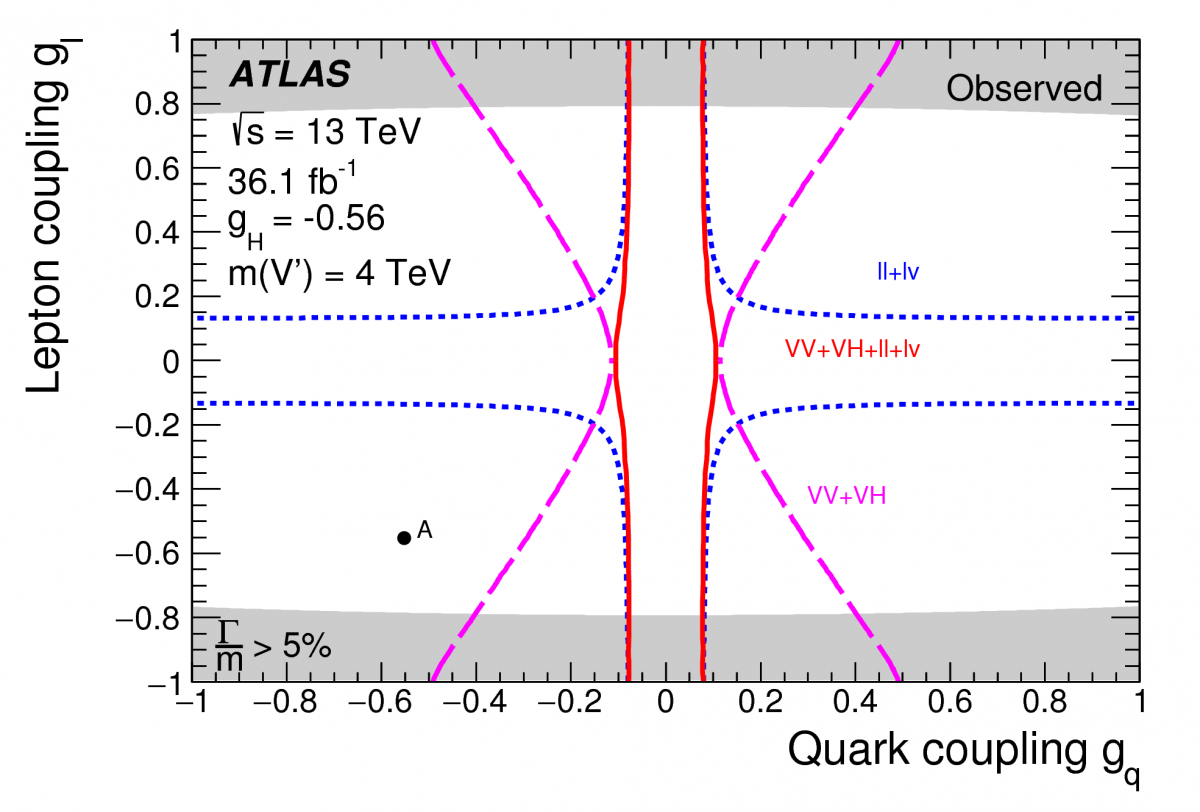Stronger together: combining searches for new heavy resonances
14 August 2018 | By

While the Standard Model has proven tremendously successful, much experimental evidence points to it not being a complete description of our universe. The search for “new physics” is therefore an important component of the ATLAS experimental programme, where a number of analyses are looking for signs of new heavy particles decaying to different final states. Though these searches have not yet found a significant signal, they have allowed physicists to place stringent constraints on different new physics scenarios. These can be further tightened by combining different analysis channels and approaches.
The ATLAS and CMS collaborations had previously combined searches for new particles decaying to pairs of W or Z bosons, or to a W/Z boson with a Higgs boson. A recently released ATLAS result extends these combinations to include – for the first time – decay channels to pairs of light leptons. The new result spans a total of 14 individual analyses of different final states, all using 2015-2016 data of 13 TeV proton-proton collisions taken at CERN’s Large Hadron Collider (LHC).
In each analysis, physicists searched for a narrow resonant peak over smooth background indicative of new physics. Careful consideration was required in the combination: the event selections of the individual analyses were designed to avoid events appearing in more than one analysis channel and correlations between channels were taken into account in the statistical analysis.
The new ATLAS result extends the combined searches for new particles to include – for the first time – decay channels to pairs of light leptons.

The new combination places constraints on three new physics models: one postulates a new heavy Higgs-like particle; another a new heavy W/Z boson, based on a Heavy Vector Triplet (HVT) model invoking an extended electroweak sector; and the third, the excitation of a graviton in models with extra spatial dimensions. Constraints obtained by the combination are improved significantly over the most sensitive individual channels. For example, the lower mass limit on graviton excitations increases from 1.7 TeV to 2.3 TeV, and that on new heavy W/Z bosons in a weakly coupled HVT model increases from 4.6 TeV to 5.5 TeV. In the HVT model, the couplings of new particles to quarks and leptons are free parameters. Individual analyses only constrain a subset of these coupling parameters or have a limited sensitivity to them, but together they lead to much stronger simultaneous constraints, exploiting their complementarity (see Figure 1). The new combination also improves existing constraints that used precision electroweak measurements, which are only indirectly sensitive to the new heavy particles (see Figure 2).
In the future, this combination programme could be further extended. A particularly promising prospect is the inclusion of channels with pairs of light quarks or top quarks. These channels more precisely probe the coupling of new particles to quarks, which complement the sensitivity of current channels and also provide a probe for new physics coupling more strongly to third generation quarks
Links:
- Combination of searches for heavy resonances decaying into bosonic and leptonic final states using 36 fb−1 of proton–proton collision data at 13 TeV with the ATLAS detector (Phys. Rev. D 98 (2018) 052008, arXiv: 1808.02380, see figures).
- Searches for heavy diboson resonances in proton–proton collisions at 13 TeV with the ATLAS detector (arXiv: 1606.04833, JHEP 09 (2016) 173).
- CMS Collaboration: Combination of searches for heavy resonances decaying to WW, WZ, ZZ, WH, and ZH boson pairs in proton–proton collisions at 8 TeV and 13 TeV (Phys. Lett. B 774 (2017) 533, arXiv: 1705.09171)
- See also the full lists of ATLAS Conference Notes and ATLAS Physics Papers.


